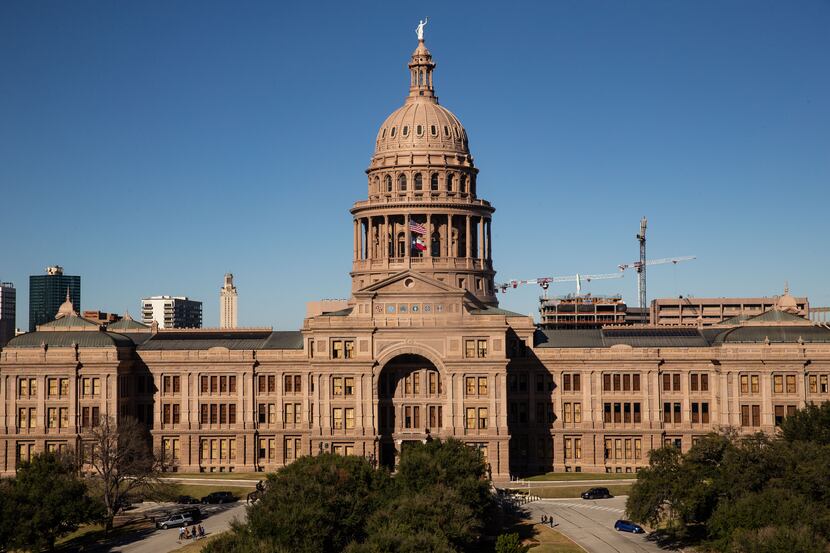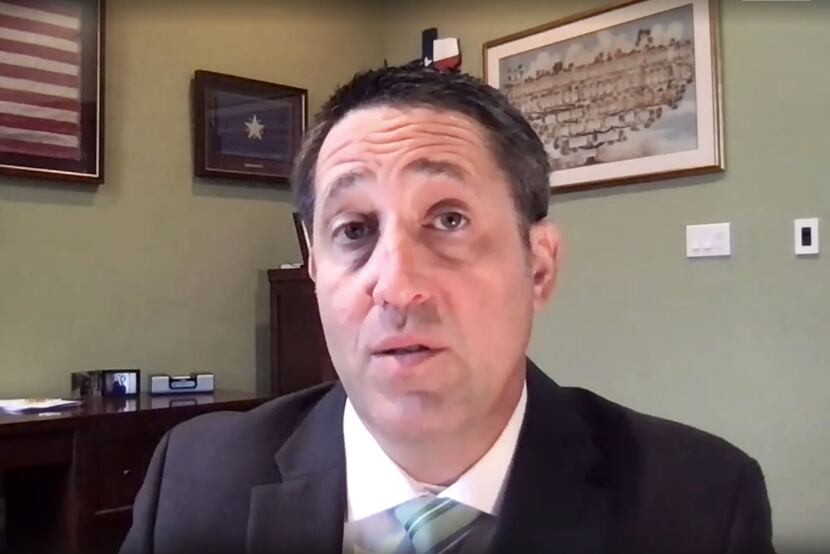Updated at 2:25 p.m.: to include a liberal analyst’s call to spend rainy-day dollars and top oil and gas lobbyist Todd Staples’ reactions.
AUSTIN — Comptroller Glenn Hegar on Monday estimated that Texas will have $112.5 billion of available general-purpose revenue in the next two-year budget cycle.
While that’s almost $7 billion less than he put on the table two years ago, it was good news because it was widely known that legislative budget writers wouldn’t start their task with a $4.8 billion cushion of general revenue, as they did last time.
Also, the state’s snared more sales tax from a surging amount of e-commerce. That helped Hegar to vastly decrease his July prophecy that there’d be a $4.6 billion deficit in the general revenue fund come Aug. 31. Instead, the shortfall will be under $1 billion — $946 million, he said.
In another piece of good news, Texas collections of general-purpose state taxes will grow by 6.7% in the two-year budget cycle that begins Sept. 1, Hegar said.
“The Legislature still is going to have to make some tough budget decisions,” noted Hegar, a Republican in his second term as the state’s chief tax collector and revenue estimator.
But he said his forecast increases the odds that writing a budget in this year’s session, while not easy, won’t necessarily require crippling spending cuts.
Hegar noted that he witnessed — and helped pass, over Democrats’ objections — such spending reductions in 2003, his first session as a state representative; and again in 2011, when he was a state senator.
Under the state Constitution, Hegar’s biennial revenue estimate sets a limit on what the Legislature can spend in the next two years.
In a Microsoft Teams video call that experienced technical difficulties before he finished his presentation, Hegar was asked by legislative staff members if he might increase his revenue estimate before the session, which begins Tuesday, ends in late May.
“We may adjust those numbers come April or May,” responded Hegar.
It was a wry reference to his and previous comptrollers’ practice of helping lawmakers wrap up a late-session budget deal by effectively giving them more money to spend.
This year’s estimate, though, could significantly overestimate — or undershoot — actual economic activity 30 months or so from now, he admitted.
The estimate is “clouded with uncertainty,” Hegar said in a written statement.
“The ultimate path of the pandemic and the behavior of consumers and businesses during a resurgence are difficult to gauge,” he said.
“It’s also unclear how they’ll respond once the pandemic is fully under control. As a result, there is a wide range of possible outcomes for state revenue through the end of fiscal 2023, with the possibility of revenue falling short of this forecast but also a chance revenue could exceed it, perhaps substantially.”

Revenue outlook brightens
In July, Hegar erased his previous forecast of a $2.9 billion surplus this cycle, and slashed by 9.5% — or $11.6 billion — his earlier guess of how much general-purpose revenue would be available in the 2020-2021 cycle.
Since then, things have brightened, Hegar said.
Pointing to better sales tax receipts than he expected, he said:
“People have continued to spend as they’re working [at] home, teleworking, [they] have done a tremendous amount of work in and around the home — home improvement projects, workout equipment, outdoor type activity. So retail has been higher, has really been the one that’s been positive.”
Also, a more aggressive approach to collecting sales tax from online sellers — specifically, marketplace providers and remote sellers — has yielded an additional $1.3 billion of sales tax in just one year, he said.
While an oil slump has hurt collection of oil and natural gas severance tax, and pulled down sales-tax collections for materials and equipment used in energy exploration, retail sales’ strength largely has offset that, he said.
Sales tax will account for 62% of all state tax collections in 2022-2023, he explained.

Collections from energy-production taxes, hotel occupancy taxes, alcoholic beverage excise taxes and mixed-beverage taxes are down, Hegar noted. That reflects COVID-19′s ravaging of leisure, vacation and hospitality industries, including bars and restaurants, he said.
However, sales of alcohol shifted to groceries and package stores, where they generate other taxes, he noted.
“People will continue to consume alcohol in some form or fashion,” Hegar said.
Also easing budget writers’ task is the continuing increase in property values, he said. Through a complex system of paying for public schools, higher property values shift the burden of paying from the state to homeowners and businesses paying school district property taxes.
Congress’ and President Donald Trump’s latest coronavirus relief package, which sent out $600 stimulus checks, won’t have a huge impact but will help the state’s immediate fiscal picture, Hegar said. That bill and previous federal legislation’s increase of Medicaid matching money to states also eases state budget pressures.
Unknowns as lawmakers gather include how big a supplemental spending bill they’ll have to pass to patch holes in the budget they passed last time, whether President-elect Joe Biden and Congress deliver states more COVID-19 aid and the pace and success of the coronavirus vaccine rollout, Hegar said.
“The more we have confidence as consumers, the better the economy is going to recover,” he said.
Nationally, credit-card debt is down and household savings are up, Hegar noted.
“Some people are significantly hurting, unfortunately,” he said. “Others, their lives continue to go in a direction, [they] continue to have activity economically, just in a different format. And so therefore there is a substantial potential for the economy to have significant uptick in the upcoming 18 months [to] 36 months.”
Hegar’s projection of a $946 million general-revenue shortfall in the current cycle didn’t account for 5% cuts in state agencies’ spending that “Big 3” leaders ordered in recent months. Those were only applied to about one-third of state spending, and will save about $1 billion, Hegar said.
The state’s “rainy day fund” will continue to grow, to $11.6 billion by Aug. 31, 2022, unless lawmakers spend some, he said.
Liberal budget analyst Eva DeLuna Castro of the group Every Texan said many state residents are hurting because of the pandemic, which means lawmakers shouldn’t hesitate to draw down some of that money “for the purposes that for which it was intended” — smoothing out the boom-bust cycles’ harm to higher education, public schools, public safety and health care programs.
In the last session that required major spending cuts – 2011 – Republicans who were used to spending rainy-day dollars increasingly spoke of a need to protect the fund, she recalled.
“It’s a pile of money,” DeLuna Castro said. “We don’t protect a pile of money. We need to make sure that Texans have what they need to help our local economies recover.”
Oil and gas prices
Oil and gas severance tax receipts over certain levels generate most of the rainy day fund’s income.
In fiscal 2022, which starts Sept. 1, the price of West Texas intermediate crude oil will average $49 a barrel; and in fiscal 2023, $55 a barrel, Hegar estimated.
Oil prices are notoriously volatile, he said. Hegar said he expects no “drastic recovery” in either prices or production levels “at least for the next 12 or 18 months.”
Texas Oil & Gas Association president Todd Staples, asked about Hegar’s oil price projections, acknowledged “there’s a wide range” of possible scenarios.
“The industry is strengthening, we are rebounding from the difficulties that were faced last year,” he said.
Staples noted that hand sanitizers, face shields and nearly every other form of PPE used during the pandemic to curb virus spread are oil and natural gas byproducts. Much of the electricity needed to power computers and homes comes from natural gas, he said.
“We will be making products with oil and gas well into the future,” he said.
The 2021 session’s budget woes aren’t as bad as earlier ones, Hegar said.
In 2003, lawmakers passed spending cuts to erase a revenue shortfall of between $10 billion and $15 billion. The official figure was $9.9 billion but it omitted significant other costs such as a new state health insurance program for school district employees and nondiscretionary budget items, such as Medicaid and foster care caseload growth.
Triggering the 2003 budget crisis were a burst of the dot-com economic bubble and the Sept. 11, 2001, terror attacks.
In 2011, during the Great Recession, Texas lawmakers closed a $27 billion shortfall — again with no tax increases, just cuts and accounting tricks. The pain of the financial collapse was masked in their 2009 session by federal stimulus money, which went away.
“This current two-year budget cycle is in much better shape compared to both of those,” Hegar said.

